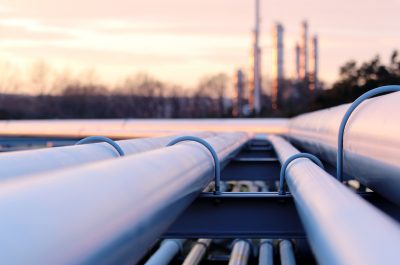Network Performance Report: More reliable and at lower cost
The Australian Energy Regulator’s (AER) 2023 Electricity Network Performance Report is an annual snapshot of the operational and financial performance of regulated electricity networks, collectively known as network service providers (NSPs). This is the fourth report of its kind that the AER has published and it focuses on core measures such as network revenue and reliability. The report demonstrates that as network businesses continue to drive efficiencies, customers are benefiting through reduced network charges.
Lower network charges for customers
Consumers’ electricity bills comprise several components, including network costs, wholesale market costs, retail margins and jurisdictional costs. As shown in Figure 1 below, the revenue that network businesses recovered from customers was lower in 2021 and 2022 than any other year since 2010.
Network revenue in 2022 continues a downwards trend since 2015, meaning customers in total are continuing to pay less for the network component of their electricity bill, with growth in customer numbers magnifying this effect on an individual customer basis.
Figure 1: Total core regulated network service revenue recovered from consumers – Distribution and transmission network service providers
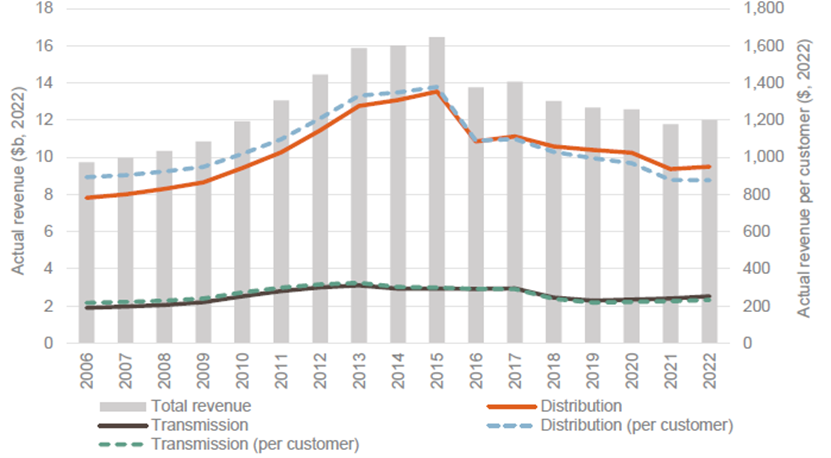
Source: AER Electricity Network Performance Report 2023
Ever more reliable
In the context of this report, reliability refers to continuous electricity supply. Reliability trends combined with the downwards trend in revenue shows that networks are continuing to deliver improved reliability and service at less cost to customers.
Customers, on average, continue to experience fewer distribution outages. As shown in Figure 2, the frequency of distribution outages continues a downward trend since 2010.
The frequency of unplanned disruptions have declined the most over this period, declining 2.9% on average per year. In 2022, there was approximately one normalized unplanned outage per customer compared to 1.4 in 2010.
Figure 2: Frequency of distribution outages – Whole of National Electricity Market
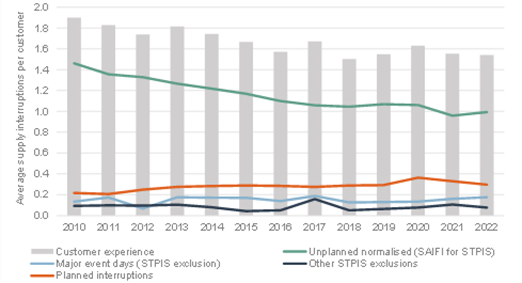
Source: AER Electricity Network Performance Report 2023
Despite a slight increase in 2022, the duration of unplanned outages per customer follows a declining long-term trend. However, the duration of unplanned outages presents more year-on-year volatility and does not clearly present a consistent trend.
Reliability measures exclude major event days, such as the Queensland floods over February-March 2022 and 2019-20 summer bushfires. While very few events are excluded, it can have a large impact on the average duration of outages and the customer experience. Therefore, there is an ongoing need to consider the impact of extreme weather-related events on electricity network performance and the resilience of the network.
Inflationary Impacts
The return on regulated equity measures the final returns available to equity holders after all expenses. It is also important to consider that the returns on regulated equity is a bespoke measure that requires care to interpret and cannot necessarily be directly compared with returns on equity achieved by firms operating in the broader competitive market.
Allowed regulatory returns have reduced significantly through the period from 2014 to 2022 to be around half the levels they were in 2014. In 2022, the weighted average network returns increased over three percentage points compared to 2021, causing an unusual spike as shown in Figure 3.
Figure 3: Real returns on regulated equity versus allowed returns on equity—NSPs
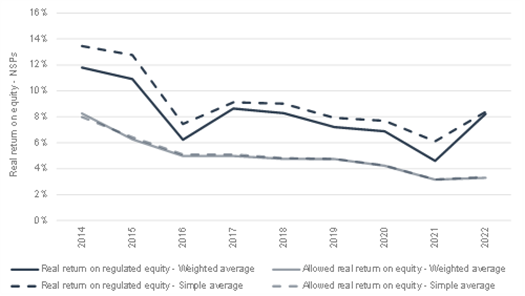
Source: AER Electricity Network Performance Report 2023
The sharp uptick in 2022 in the regulated return on equity can be linked to higher-than-expected inflation causing a one-off impact of increasing measured real returns on equity. The uptick is also following an extended period of lower than forecast inflation reducing measured returns on regulated equity over the past decade, as illustrated in Figure 4.
Figure 4: Inflation impact on real returns on regulated equity compared with actual and forecast inflation
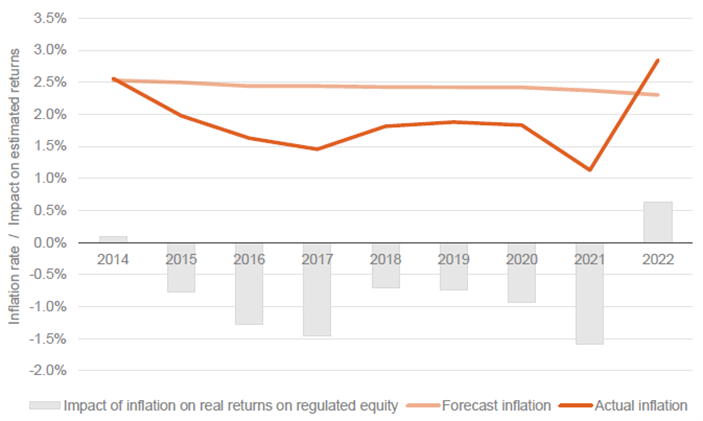
Source: AER Electricity Network Performance Report 2023
Looking forward
Networks have continued to improve reliability despite the ever-changing economic landscape and the significant challenge of transforming the physical power system to net zero. Despite these challenges, networks continue to be the most stable part of the energy supply chain while delivering an essential service to nearly every home and business across Australia. However, it is important to note that the report is based on historical data and does little to indicate what the future will hold.
Like other businesses, network businesses may also face greater input cost pressures in the future but will seek to actively manage these potential increases for customers as networks work to deliver Australia’s transition to net zero.
